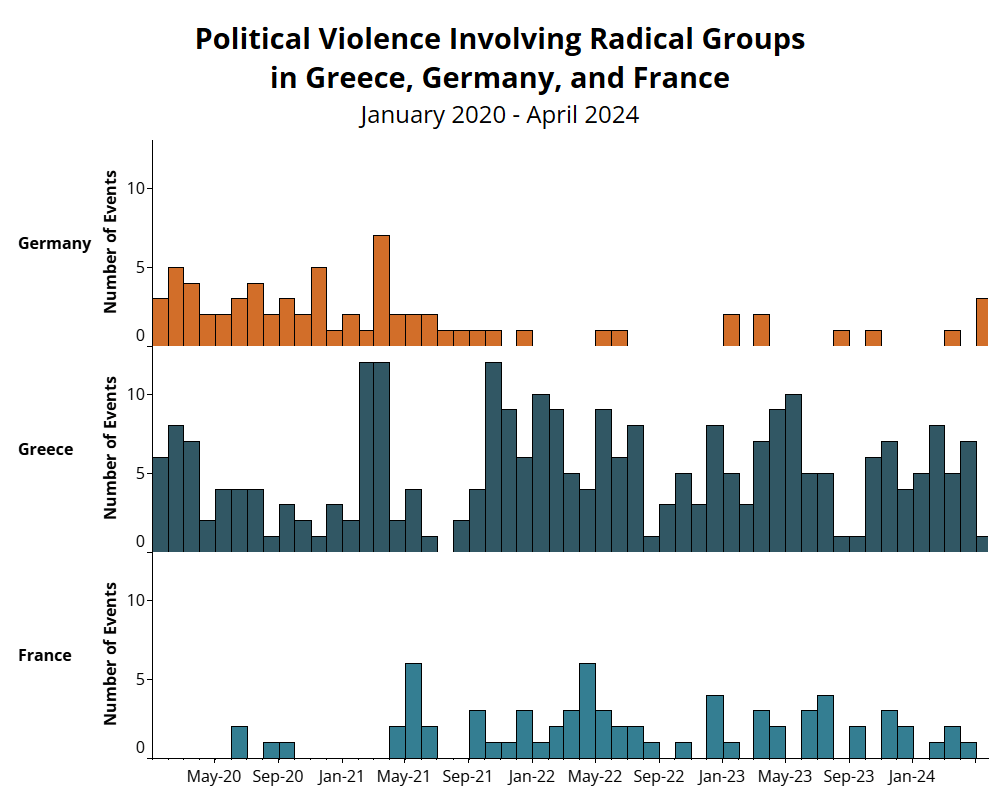Violent attacks on European politicians over the past two months, coinciding with the rising popularity of radical political parties ahead of the 9 June elections in Europe, have given the impression that radicalized violence is on the rise. In fact, ACLED data show that overall radical violence in Europe has remained at nearly the same level since data collection began in 2020 and that the far right is behind 85% of it.
On 15 May, a man shot and gravely wounded Slovakia’s recently re-elected populist Prime Minister Robert Fico. He invoked disagreement with the Fico government’s crackdown on the media and the judiciary as a reason for the attack.1Tom Nicholson, ‘Roots of Robert Fico’s shooting lie in Slovakia’s bitter divides,’ Politico, 15 May 2024 Earlier in April and May, suspected far-right activists assaulted several Socialist and Greens candidates and campaigners in Germany and attacked an anti-fascist event in Stockholm organized by the Left and Green parties. While the assassination attempt on Fico occurred in response to election results, the incidents in Germany and Sweden are likely linked to the European Parliament elections slated for 6 to 9 June.
In fact — despite the recent high-profile incidents involving radical groups and a slight increase in 2021 — violence by radical groups in the EU as a whole has remained constant since 2020. ACLED has tracked far-right activity in 22 of the EU’s 27 members since 2020, and far-left and anarchist group activity in 10 countries (see graph below).2The far-right, the far-left, and anarchist groups include established parties and named and unnamed groups of varying degrees of militancy. For the purposes of this analysis, the far -right are viewed in opposition to the far -left and anarchist groups. While this includes over 100 violent events involving far-left and far-right groups across the EU in 2023, this number is not higher than in previous years.
Since 2020, events in Greece, France, and Germany have accounted for the largest share of violence by radical groups — 57%, 15%, and 14%, respectively (see maps below). ACLED records targeted attacks in 12 EU countries with the far right involved in 85% of cases, or at least 55 of about 65 incidents.
While the trend maintains a progressive decline, the context does not rule out under-the-radar radicalization of the political scene. Far-right parties are projected to boost their legislative clout after the vote. Greece, France, and Germany each have active far-right political parties; however, the threat of the radicalization of politics in the European Union3Kevin Cunningham et al, ‘A sharp right turn: A forecast for the 2024 European Parliament elections,’ European Council on Foreign Relations, 23 January 2024 does not necessarily stem from a rise in violent activity associated with those ideologies.
In Greece, over 80% of violent events by radical groups involve far-left and anarchist groups engaged in street war with the far right and police. Far-left and anarchist groups recently claimed responsibility for a string of attempted bombings since July 2023, including an explosion near the Labor Ministry in Athens on 3 February 2024. The Greek far right is involved in only 16% of violent acts, mostly targeting religious and sexual minorities, as well as migrants. However, far-right activity picked up around the May 2023 elections, during which ACLED observed the normalization of violence against political competitors and even ordinary citizens.4I Avgi, ‘Achilleas Beos / Out of control – He used water pressure from a fire-truck hose against a citizen who was in the campaign office of a political opponent’, 30 September 2023
In France, while violent levels remain relatively low, the far right appears to be proliferating under the radar and increasingly engaging in vigilantism. In recent events, these groups have assaulted people of immigrant heritage on the streets under the pretense of ‘helping’ police amid intercommunal tensions.5Matthieu Suc and Marine Turchi, ‘Nahel : ces milices d’extrême droite qui se substituent à la police,’ Mediapart, 3 July 2023; Hayet Kechit, ‘Crépol : des policiers auraient livré la liste des suspects et de leurs proches aux militants d’extrême droite,’ L’Humanité, 7 December 2023 The killing of Thomas Perotto in a brawl in Crépol in November 2023 galvanized far-right groups even further, with some going as far as ‘patrolling’ the Monnaie neighborhood of Romans-sur-Isère to fight the youths they deemed responsible for Perotto’s death.6Arthur Weil-Rabaud and Daphné Deschamps, ‘Le Rassemblement national et les radicaux poursuivent leur collaboration,’ Streetpress, 30 November 2023 Racist violence also affects local officials,7Elaine Ganley, ‘French mayors face violence and intimidation from xenophobic far-right groups,’ AP, 19 February 2024 who have already been under increased pressure on the streets. The French government responded to increased far-right activism by beefing up police presence, banning ‘ultra-right-wing’ demonstrations,8AFP, ‘Face à la polémique, le gouvernement promet d’interdire toutes les manifestations d’ultradroite,’ Le Point, 9 May 2023 and further dissolving radical groups9RFI, ‘Ultra-right group disbanded after violent clashes in south of France,’ 7 December 2023 through a legal provision repeatedly used against far-left and environmental groups as well.10Abel Mestre, ‘La dissolution de groupes radicaux d’extrême droite ou d’extrême gauche, une mesure aux effets limités,’ Le Monde, 5 June 2023
In Germany, the uncovering of a mass deportation plot amplified the ongoing mainstream challenge against the far right.11Kirsten Grieshaber, ‘Germans thought they were immune to nationalism after confronting their Nazi past. They were wrong,’ AP, 18 March 2024 In November 2023, high-ranking Alternative for Germany (AfD) party officials and European far-right activists mulled the mass deportation of German citizens with migration backgrounds during a meeting in Potsdam.12Correctiv, ‘Secret plan against Germany,’ 15 January 2024 The revelation stirred a wave of demonstrations against right-wing extremism across Germany. Between January and mid-May 2024, ACLED records over 1,000 related demonstrations, including more than 380 in January alone.
Visuals produced by Ana Marco.







